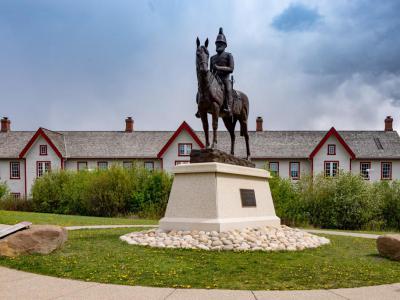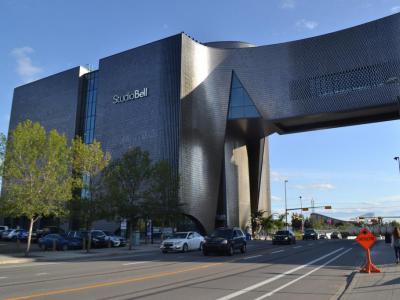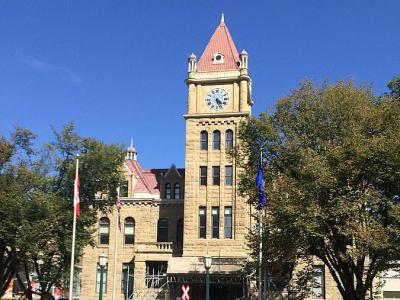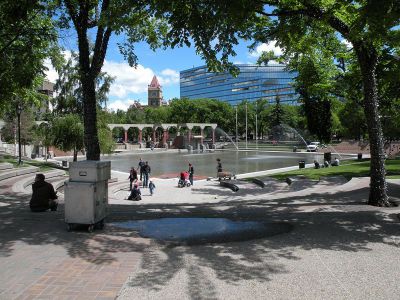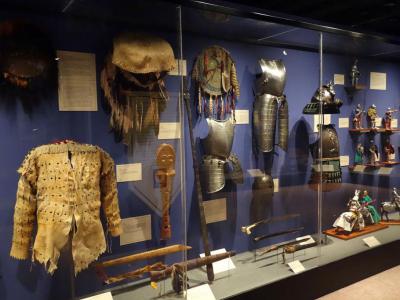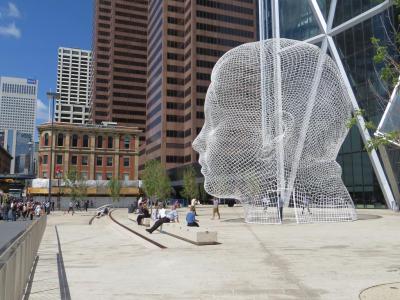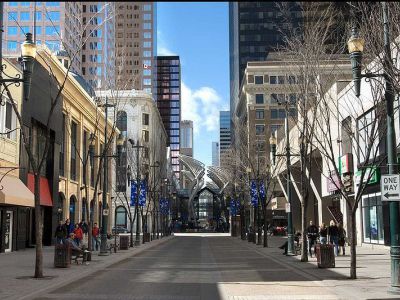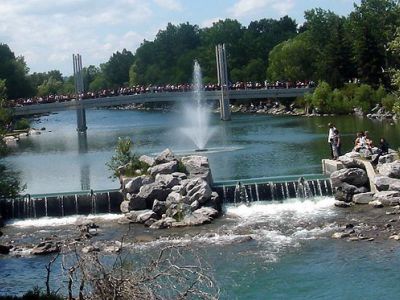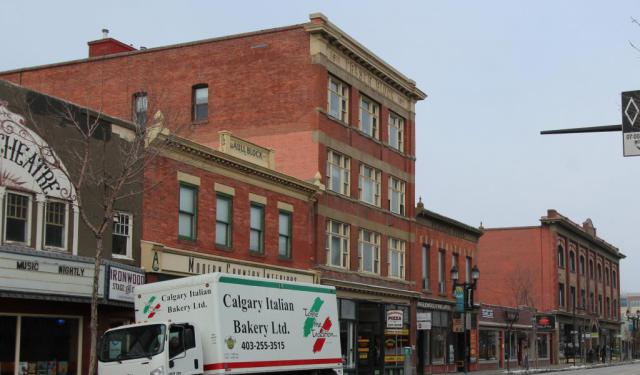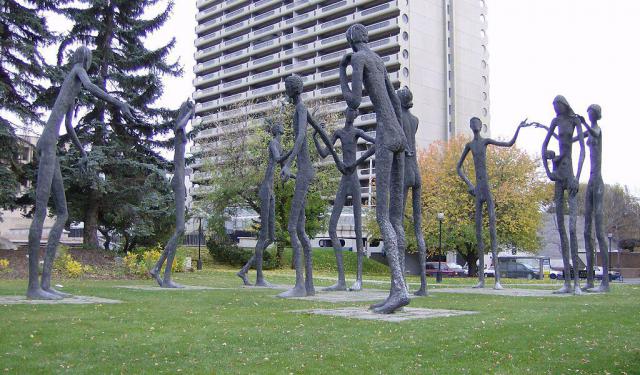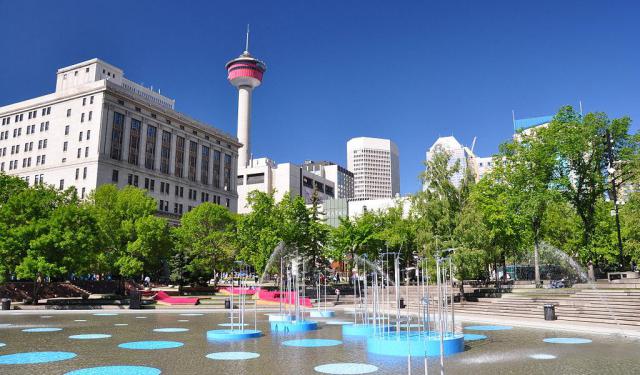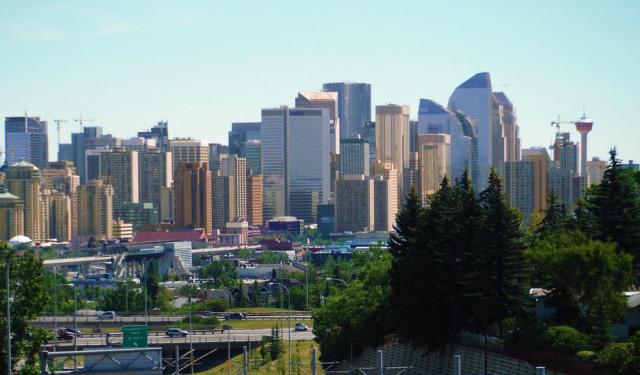
Calgary Introduction Walking Tour (Self Guided), Calgary
Calgary is the largest city in Western Canada and one of the most popular tourist destinations in the country. The city was named after a hamlet with the same name on the Isle of Mull, Scotland.
The area that is called Calgary today was once populated by indigenous people, now known as the First Nations, until Europeans arrived in the 19th century.
John Glenn, an Irish immigrant who served in the American Civil War, was the first documented European to settle in the area. Glenn and his wife built a small log cabin near the confluence of Fish Creek and the Bow River. Glenn's settlement attracted other European settlers to the area.
Calgary rapidly grew in size and within 15 years of John Glenn's arrival, the area was incorporated as a city. Hudson's Bay Company moved into Calgary in 1884, which was followed by a series of farmers and ranchers who homesteaded in the region. An oil boom in the early 20th century brought even more growth and prosperity.
The attractions many visitors see today have their roots in Calgary's early years. The Downtown East Village is among the most popular spots for tourists to visit. This neighborhood is home to Fort Calgary, which is the earliest settled spot in the area. Nearby spots to explore by foot are the Riverwalk, the National Music Centre, Calgary City Hall and Devonian Gardens at the Core Shopping Centre, among many others. Public art installations to include on any walking tour consist of the Wonderland Statue at the Bow Skyscraper and the Ten Trees on the Stephens Avenue Walk.
Take this self-guided tour to explore the beautiful city of Calgary.
The area that is called Calgary today was once populated by indigenous people, now known as the First Nations, until Europeans arrived in the 19th century.
John Glenn, an Irish immigrant who served in the American Civil War, was the first documented European to settle in the area. Glenn and his wife built a small log cabin near the confluence of Fish Creek and the Bow River. Glenn's settlement attracted other European settlers to the area.
Calgary rapidly grew in size and within 15 years of John Glenn's arrival, the area was incorporated as a city. Hudson's Bay Company moved into Calgary in 1884, which was followed by a series of farmers and ranchers who homesteaded in the region. An oil boom in the early 20th century brought even more growth and prosperity.
The attractions many visitors see today have their roots in Calgary's early years. The Downtown East Village is among the most popular spots for tourists to visit. This neighborhood is home to Fort Calgary, which is the earliest settled spot in the area. Nearby spots to explore by foot are the Riverwalk, the National Music Centre, Calgary City Hall and Devonian Gardens at the Core Shopping Centre, among many others. Public art installations to include on any walking tour consist of the Wonderland Statue at the Bow Skyscraper and the Ten Trees on the Stephens Avenue Walk.
Take this self-guided tour to explore the beautiful city of Calgary.
How it works: Download the app "GPSmyCity: Walks in 1K+ Cities" from Apple App Store or Google Play Store to your mobile phone or tablet. The app turns your mobile device into a personal tour guide and its built-in GPS navigation functions guide you from one tour stop to next. The app works offline, so no data plan is needed when traveling abroad.
Calgary Introduction Walking Tour Map
Guide Name: Calgary Introduction Walking Tour
Guide Location: Canada » Calgary (See other walking tours in Calgary)
Guide Type: Self-guided Walking Tour (Sightseeing)
# of Attractions: 11
Tour Duration: 2 Hour(s)
Travel Distance: 3.9 Km or 2.4 Miles
Author: AnnaO
Sight(s) Featured in This Guide:
Guide Location: Canada » Calgary (See other walking tours in Calgary)
Guide Type: Self-guided Walking Tour (Sightseeing)
# of Attractions: 11
Tour Duration: 2 Hour(s)
Travel Distance: 3.9 Km or 2.4 Miles
Author: AnnaO
Sight(s) Featured in This Guide:
- Fort Calgary
- Studio Bell - National Music Centre
- Old City Hall
- Olympic Plaza
- Glenbow Museum
- Wonderland Sculpture
- Stephen Avenue
- Calgary Tower
- Devonian Gardens in Core Shopping Center
- Chinatown
- Prince's Island Park
1) Fort Calgary (must see)
Fort Calgary was constructed in 1875 under federal orders. The fort was established predominantly to extricate whiskey traders settled in that area. This fort is located at the junction of Elbowrivers and Bow in Calgary.
The exact spot to construct the fort on the Bow was identified by the F Troop that traveled upon Ephrem A. Brisebois’ command from Fort Macleod. The troop set foot on the Bow using a makeshift tarpaulin and wagon box. The first member who set foot on the Bow is Corporal George Clift King which is why he is referred to as the first citizen of Calgary.
Spruce logs from upstream and pine were materials used to construct the fort. It consists of buildings such as the men’s quarters, storage facilities, stables and guard room. Originally, the fort was named “Bow Fort” or “The Elbow”.
There was an attempt to name the fort after Captain Brisebois. As he was not very popular, the attempt was unsuccessful and the fort was eventually renamed Fort Calgary in 1876. In 1882, new barracks were constructed by tearing down parts of the old fort. In 1888, due to the destruction of a barrack in 1884, a two story building was constructed with a capacity of housing 100 men.
Fort Calgary is a must-see attraction for anyone who wants to know the history of Calgary. It is frequented by thousands of tourists and locals each year.
The exact spot to construct the fort on the Bow was identified by the F Troop that traveled upon Ephrem A. Brisebois’ command from Fort Macleod. The troop set foot on the Bow using a makeshift tarpaulin and wagon box. The first member who set foot on the Bow is Corporal George Clift King which is why he is referred to as the first citizen of Calgary.
Spruce logs from upstream and pine were materials used to construct the fort. It consists of buildings such as the men’s quarters, storage facilities, stables and guard room. Originally, the fort was named “Bow Fort” or “The Elbow”.
There was an attempt to name the fort after Captain Brisebois. As he was not very popular, the attempt was unsuccessful and the fort was eventually renamed Fort Calgary in 1876. In 1882, new barracks were constructed by tearing down parts of the old fort. In 1888, due to the destruction of a barrack in 1884, a two story building was constructed with a capacity of housing 100 men.
Fort Calgary is a must-see attraction for anyone who wants to know the history of Calgary. It is frequented by thousands of tourists and locals each year.
2) Studio Bell - National Music Centre (must see)
Any walking tour in Calgary should include Downtown East Village. This area was the first settled region of Calgary, as evidenced by the presence of Fort Calgary. A highlight of Downtown East Village is the National Music Center.
Visitors might find some confusion over the museum's name. It is officially called the National Music Center, but the building that houses the museum is Studio Bell. No matter what name is used, it is a must-see attraction in Calgary.
Tourists can see permanent exhibitions at the National Music Center. The Music Mosaic covers the history of music in Canada. Along with musicians, visitors learn about inventors and broadcasters. The Power of Music is a permanent exhibit that lets visitors join in by singing in one of the vocal booths, watching live performances and learning how music affects the body and the brain. Making Music allows visitors to play different musical instruments. These range from drums to a baby grand piano.
Another permanent exhibit at the National Music Center is the Canadian Music Halls of Fame. The Halls of Fame honor those artists that have shown the world the prolific nature of music in Canada. Among the many artists who are celebrated are the Cowboy Junkies, Andy Kim, Barenaked Ladies, Sarah McLachlan, Alanis Morissette, Backman-Turner Overdrive, k.d. lang, Shania Twain, Bryan Adams, David Foster, Rush, Leonard Cohen, Guy Lombardo, Oscar Peterson and many others.
The National Music Center offers regular concerts and events. Those lucky Calgary tourists who visit during one of these special events may see a musical performance, a film screening or art on tour. The Studio Bell website has a full calendar of upcoming events that tourists can check when making their plans.
Why You Should Visit:
- To learn about music with hands-on exhibits
- To pay homage to some of Canada's greatest musical influencers
Tips:
Visitors should plan their trip to the National Music Center carefully. They must purchase timed tickets in advance and arrive at the time indicated on their tickets. Studio Bell is open on Saturdays and Sundays from 10 AM through 5 PM.
Visitors might find some confusion over the museum's name. It is officially called the National Music Center, but the building that houses the museum is Studio Bell. No matter what name is used, it is a must-see attraction in Calgary.
Tourists can see permanent exhibitions at the National Music Center. The Music Mosaic covers the history of music in Canada. Along with musicians, visitors learn about inventors and broadcasters. The Power of Music is a permanent exhibit that lets visitors join in by singing in one of the vocal booths, watching live performances and learning how music affects the body and the brain. Making Music allows visitors to play different musical instruments. These range from drums to a baby grand piano.
Another permanent exhibit at the National Music Center is the Canadian Music Halls of Fame. The Halls of Fame honor those artists that have shown the world the prolific nature of music in Canada. Among the many artists who are celebrated are the Cowboy Junkies, Andy Kim, Barenaked Ladies, Sarah McLachlan, Alanis Morissette, Backman-Turner Overdrive, k.d. lang, Shania Twain, Bryan Adams, David Foster, Rush, Leonard Cohen, Guy Lombardo, Oscar Peterson and many others.
The National Music Center offers regular concerts and events. Those lucky Calgary tourists who visit during one of these special events may see a musical performance, a film screening or art on tour. The Studio Bell website has a full calendar of upcoming events that tourists can check when making their plans.
Why You Should Visit:
- To learn about music with hands-on exhibits
- To pay homage to some of Canada's greatest musical influencers
Tips:
Visitors should plan their trip to the National Music Center carefully. They must purchase timed tickets in advance and arrive at the time indicated on their tickets. Studio Bell is open on Saturdays and Sundays from 10 AM through 5 PM.
3) Old City Hall
The Calgary City Hall has been used as a municipal building since it was constructed in 1911. It was designed in a Richardsonian Romanesque architectural style by William M. Dodd. The revivalist style of architecture draws inspiration from 11th and 12th century Romanesque buildings with recessed windows, stone arches and a symmetrical structure.
The building has undergone a number of restoration projects. The most recent took place in 2014 when bits of the stone walls began to crumble from the Old City Hall's exterior. The building was designated as a Provincial Historical Resource in 1978. It was given National Historical Site status in 1984.
The Old City Hall remains in use. It is home to the Calgary mayor's office as well as members of the city council. The Old City Hall is the site of Calgary City Council meetings as well. Visitors to the city can see for themselves how the city has grown around this site. Nearby areas of interest include the Central Library and Olympic Plaza.
The building has undergone a number of restoration projects. The most recent took place in 2014 when bits of the stone walls began to crumble from the Old City Hall's exterior. The building was designated as a Provincial Historical Resource in 1978. It was given National Historical Site status in 1984.
The Old City Hall remains in use. It is home to the Calgary mayor's office as well as members of the city council. The Old City Hall is the site of Calgary City Council meetings as well. Visitors to the city can see for themselves how the city has grown around this site. Nearby areas of interest include the Central Library and Olympic Plaza.
4) Olympic Plaza
Olympic Plaza is one of the popular tourist attractions in Calgary. This plaza was constructed during the 1988 Winter Olympics exclusively as a venue for medal presentation. Here you will find a legacy hall that commemorates the winners through display of plaques. Today, Olympic Plaza is used for hosting festivals and concerts.
Olympic Plaza is abuzz with activities during the cheery summer months. There are festivities and music in the air and sparkling water fountains. During lunch hour, downtown patrons frequent the park. The Stampede breakfast and the exciting Latino-fest are held at this plaza. If you think this park is deserted during the chilly winter months, think again. The wading pool is converted to a skating rink and people come in large numbers to enjoy skating.
Many popular events continue to be held at the Olympic Plaza on a regular basis; among them are Canada Day fireworks, New Years Eve celebrations, Pride celebrations and a public thank you rally that took place in June 2004 after the Calgary Flames reached the NHL finals.
Olympic Plaza is the epicenter of Calgary’s culture. Epcor Center of Performing Arts hosts many shows here throughout the year. On your trip to Calgary, do not miss a chance to visit this wonderful tourist attraction.
Olympic Plaza is abuzz with activities during the cheery summer months. There are festivities and music in the air and sparkling water fountains. During lunch hour, downtown patrons frequent the park. The Stampede breakfast and the exciting Latino-fest are held at this plaza. If you think this park is deserted during the chilly winter months, think again. The wading pool is converted to a skating rink and people come in large numbers to enjoy skating.
Many popular events continue to be held at the Olympic Plaza on a regular basis; among them are Canada Day fireworks, New Years Eve celebrations, Pride celebrations and a public thank you rally that took place in June 2004 after the Calgary Flames reached the NHL finals.
Olympic Plaza is the epicenter of Calgary’s culture. Epcor Center of Performing Arts hosts many shows here throughout the year. On your trip to Calgary, do not miss a chance to visit this wonderful tourist attraction.
5) Glenbow Museum (must see)
A trip to Calgary is certainly incomplete without a visit to Glenbow Museum. This museum features a total of 20 galleries with 93,000 square feet of exhibition space. As this largest museum in Western Canada displays over one million objects, it is recommended to keep an entire day for your visit here.
You will find four permanent collections here including Ethnology, Cultural history, Mineralogy and Military history. As you browse through the collections, you will learn a lot of interesting things about Canada and its rich history.
Over 100,000 objects from all over the world are on display at the cultural history collection. Right from the 1800s, you will gain a deep insight into the life, culture and history of Western Canada.
This museum also features the largest military collection in Western Canada. Displaying over 26,000 items, this collection features Asian, European and North American firearms and other interesting artifacts spanning five centuries.
Browse through the Glenbow ethnology collection to find at least 48,000 items that take gives you a peek into those indigenous people of North America’s Northern Plains. Glenbow Museum also features Canadian medals, decorations and orders and Japanese arms and armor. Browse through the mineralogy collection to find interesting semi-precious and precious stones as well as minerals from across the world.
You will find four permanent collections here including Ethnology, Cultural history, Mineralogy and Military history. As you browse through the collections, you will learn a lot of interesting things about Canada and its rich history.
Over 100,000 objects from all over the world are on display at the cultural history collection. Right from the 1800s, you will gain a deep insight into the life, culture and history of Western Canada.
This museum also features the largest military collection in Western Canada. Displaying over 26,000 items, this collection features Asian, European and North American firearms and other interesting artifacts spanning five centuries.
Browse through the Glenbow ethnology collection to find at least 48,000 items that take gives you a peek into those indigenous people of North America’s Northern Plains. Glenbow Museum also features Canadian medals, decorations and orders and Japanese arms and armor. Browse through the mineralogy collection to find interesting semi-precious and precious stones as well as minerals from across the world.
6) Wonderland Sculpture (must see)
The Bow is a crescent shaped skyscraper in Calgary. It is a groundbreaking structure that has been ranked as one of the top 10 architectural projects in the world by "Azure Magazine." A walking tour of Calgary assuredly includes a stop by the Bow, but the reason is more for a sculpture in the plaza than for the skyscraper itself.
Wonderland is a 39-foot tall (roughly 12 meters) statue in the shape of a young girl's head. The bent wire sculpture was created by artist Jaume Plensa. It is meant to represent the dreams of the young people of the province.
Unlike most sculptures, Wonderland has an entrance that allows visitors to view the artwork from the inside. They can view the city from the perspective of all of those who are represented by this sculpture.
Wonderland is prominently displayed on 6th Avenue. It is a short walk from Olympic Plaza, making it a quick yet meaningful part of a walking tour of the city.
Wonderland is a 39-foot tall (roughly 12 meters) statue in the shape of a young girl's head. The bent wire sculpture was created by artist Jaume Plensa. It is meant to represent the dreams of the young people of the province.
Unlike most sculptures, Wonderland has an entrance that allows visitors to view the artwork from the inside. They can view the city from the perspective of all of those who are represented by this sculpture.
Wonderland is prominently displayed on 6th Avenue. It is a short walk from Olympic Plaza, making it a quick yet meaningful part of a walking tour of the city.
7) Stephen Avenue (must see)
Downtown Calgary is where all the action is and this is the hub of Calgary shopping and sightseeing. On your trip to this city, you must not miss a visit to the major pedestrian mall Stephen Avenue.
This street features some of the best cafes, bars, pubs and finest restaurants. If you love shopping this is where you must be. Stephen Avenue is a shopper’s delight with its high end retail stores and exclusive boutiques.
Some of the major shopping centers here include The Bay Department Store, Scotia Center, Fashion Central, Bankers Hall and The Core Shopping Center. Other attractions located on this street include hotels such as Calgary Marriott and Hyatt Regency Calgary and the famous Telus Convention Center.
Stephen Avenue is also where you can find many ancient, historic buildings. In 1992, the Canadian government declared this street as a Canadian historic site. Stephen Avenue got its name from the first Canadian Pacific Railway president and the first Baron Mount Stephen, George Stephen.
As you walk around the street, you will be impressed by the majestic, sandstone buildings that were built specifically to withstand fire following the 1886 fire that damaged most of the city. Remember to enjoy a visit to this popular street on your trip to Calgary.
This street features some of the best cafes, bars, pubs and finest restaurants. If you love shopping this is where you must be. Stephen Avenue is a shopper’s delight with its high end retail stores and exclusive boutiques.
Some of the major shopping centers here include The Bay Department Store, Scotia Center, Fashion Central, Bankers Hall and The Core Shopping Center. Other attractions located on this street include hotels such as Calgary Marriott and Hyatt Regency Calgary and the famous Telus Convention Center.
Stephen Avenue is also where you can find many ancient, historic buildings. In 1992, the Canadian government declared this street as a Canadian historic site. Stephen Avenue got its name from the first Canadian Pacific Railway president and the first Baron Mount Stephen, George Stephen.
As you walk around the street, you will be impressed by the majestic, sandstone buildings that were built specifically to withstand fire following the 1886 fire that damaged most of the city. Remember to enjoy a visit to this popular street on your trip to Calgary.
8) Calgary Tower (must see)
Located in downtown Calgary, Calgary Tower stands 191 meter tall. Originally known as the Husky Tower, this observation tower came into existence in 1967 as a part of the urban renewal plan. It was constructed in joint cooperation between Husky oil and Realty Company Limited. The tower was also built to celebrate the 1967 centennial of Canada. It was in 1971 that this World Federation of Great Towers founder member was renamed Calgary Tower.
Calgary Tower was designed and constructed by W. G. Milne & A. Dale and Associates. It took fifteen months to complete building this tower. It can withstand winds up to 161 kilometers per hour and earthquakes.
On your visit to this tower, check out the column that was built in a unique manner by pouring concrete continually for 24 days. Enjoy a delicious meal at the revolving restaurant here. Called Sky 360, the restaurant offers an amazing view. +15 Skyway network connects the base of the tower to Fairmont Palliser Hotel, One Palliser Square and EnCana Place.
Calgary Tower was designed and constructed by W. G. Milne & A. Dale and Associates. It took fifteen months to complete building this tower. It can withstand winds up to 161 kilometers per hour and earthquakes.
On your visit to this tower, check out the column that was built in a unique manner by pouring concrete continually for 24 days. Enjoy a delicious meal at the revolving restaurant here. Called Sky 360, the restaurant offers an amazing view. +15 Skyway network connects the base of the tower to Fairmont Palliser Hotel, One Palliser Square and EnCana Place.
9) Devonian Gardens in Core Shopping Center
Core Shopping Center is a popular spot for tourists and locals. The shopping center includes a number of stores where visitors can pick up necessities, shop for luxury items or find souvenirs. Another reason to go to the Core Shopping Center is not about shopping at all.
Devonian Gardens is an indoor botanical garden that is maintained by the city's parks department. Over 500 trees, a living wall, fountains and even a children's play area are all housed on the top floor of the shopping center.
Visitors are welcome to explore the gardens or find a seat to read a good book. Tables are available for those who would like to have an indoor lunch with an outdoor experience. There is also a public piano that is free for use and a playground just for children.
There is no cost to enjoy this public space. Anyone may stop by for a short visit or stay for as long as they like.
Devonian Gardens is an indoor botanical garden that is maintained by the city's parks department. Over 500 trees, a living wall, fountains and even a children's play area are all housed on the top floor of the shopping center.
Visitors are welcome to explore the gardens or find a seat to read a good book. Tables are available for those who would like to have an indoor lunch with an outdoor experience. There is also a public piano that is free for use and a playground just for children.
There is no cost to enjoy this public space. Anyone may stop by for a short visit or stay for as long as they like.
10) Chinatown
Chinatown is a district in Calgary located north of downtown and south of the Bow River. Much of the district is located on Riverfront, 2nd, 3rd and 4th Avenues from east to west and 1st and Centre Streets north and south. The area has many restaurants, shopping and interesting sights.
A walk of Chinatown can take as much or as little time as the visitor wants. A half hour of walking will cover all of the must-see spots in this district. However, visitors may want to stop to dine, shop or enjoy some of the area's entertainment.
Sien Lok Park hugs the riverfront and pays homage to the first Chinese settlers in the region. Across 1st Street from Sien Lok Park is the Calgary Chinese Cultural Center. The building includes a museum and art exhibition. Festivals, like the Chinese Lunar New Year, take place at the Calgary Chinese Cultural Center as well.
A walk of Chinatown can take as much or as little time as the visitor wants. A half hour of walking will cover all of the must-see spots in this district. However, visitors may want to stop to dine, shop or enjoy some of the area's entertainment.
Sien Lok Park hugs the riverfront and pays homage to the first Chinese settlers in the region. Across 1st Street from Sien Lok Park is the Calgary Chinese Cultural Center. The building includes a museum and art exhibition. Festivals, like the Chinese Lunar New Year, take place at the Calgary Chinese Cultural Center as well.
11) Prince's Island Park (must see)
A visit to any city is incomplete without a trip to its most popular park. Prince’s Island Park is one of the most famous parks in Calgary frequented by thousands of tourists and locals every day. This park is the ideal place for relaxing and people watching.
Catch some Vitamin D on hot summers at this 20 hectare park even as you soak in the vibrant atmosphere around. Prince’s Island Park is situated behind Eau Clair Market. The park is not just a hub of activity in summers. In winters, the pathways are filled with enthusiastic people enjoying whizzing around in roller blades and cross country skiing. You will find romance in the air at the quiet, charming River Café.
On your visit to Prince’s Island Park, do not miss the experience of watching the geese in the wetland. Gaze at the amazing natural surroundings that include a lagoon, water fountains and flower gardens. During summers, paddle along the sparkling river.
During summers, you will find the park filled with frantic activities as it is a host to various summer festivals and events. Learn how the wetland serves as an important support for the habitat, wild life and water quality by taking a stroll along the environmental learning pathway.
This enchanting park is definitely the highlight of Calgary. Locals and visitors from around the world flock here to enjoy the serene ambience.
Catch some Vitamin D on hot summers at this 20 hectare park even as you soak in the vibrant atmosphere around. Prince’s Island Park is situated behind Eau Clair Market. The park is not just a hub of activity in summers. In winters, the pathways are filled with enthusiastic people enjoying whizzing around in roller blades and cross country skiing. You will find romance in the air at the quiet, charming River Café.
On your visit to Prince’s Island Park, do not miss the experience of watching the geese in the wetland. Gaze at the amazing natural surroundings that include a lagoon, water fountains and flower gardens. During summers, paddle along the sparkling river.
During summers, you will find the park filled with frantic activities as it is a host to various summer festivals and events. Learn how the wetland serves as an important support for the habitat, wild life and water quality by taking a stroll along the environmental learning pathway.
This enchanting park is definitely the highlight of Calgary. Locals and visitors from around the world flock here to enjoy the serene ambience.
Walking Tours in Calgary, Alberta
Create Your Own Walk in Calgary
Creating your own self-guided walk in Calgary is easy and fun. Choose the city attractions that you want to see and a walk route map will be created just for you. You can even set your hotel as the start point of the walk.
Inglewood Walking Tour
Inglewood, a picturesque neighborhood on the bank of the Elbow River in central Calgary, is brimming with historical significance and natural beauty. One of its notable sites is Fort Calgary, a historic landmark that takes you back in time to the days of the Canadian frontier. Here, you can explore exhibits and learn about the city's early history, making it an ideal spot for history buffs.
... view more
Tour Duration: 2 Hour(s)
Travel Distance: 4.8 Km or 3 Miles
... view more
Tour Duration: 2 Hour(s)
Travel Distance: 4.8 Km or 3 Miles
Sculptures in Calgary Walking Tour
In Calgary, you won't find imposing grey monuments with tonnes of history behind them. Instead, the city boasts a wealth of outdoor sculptures of a different sort. It's all about the sites scattered throughout the city, rarely revealed in tourist handbooks but colorful enough to be captured in photos. Some of them weird, some outstanding, and some merely amusing.
One of the notable... view more
Tour Duration: 2 Hour(s)
Travel Distance: 2.8 Km or 1.7 Miles
One of the notable... view more
Tour Duration: 2 Hour(s)
Travel Distance: 2.8 Km or 1.7 Miles
Downtown Calgary Walking Tour
The vibrant heart of Alberta's largest city, Downtown Calgary, is a place "where urban sophistication meets western warmth in the Shadows of the Rocky Mountains." As such, the area has quite a few landmarks that showcase the city's dynamic nature.
One such is the Old City Hall, a historic sandstone building that commands attention with its majestic presence.
A short walk... view more
Tour Duration: 1 Hour(s)
Travel Distance: 0.6 Km or 0.4 Miles
One such is the Old City Hall, a historic sandstone building that commands attention with its majestic presence.
A short walk... view more
Tour Duration: 1 Hour(s)
Travel Distance: 0.6 Km or 0.4 Miles
The Most Popular Cities
/ view all
